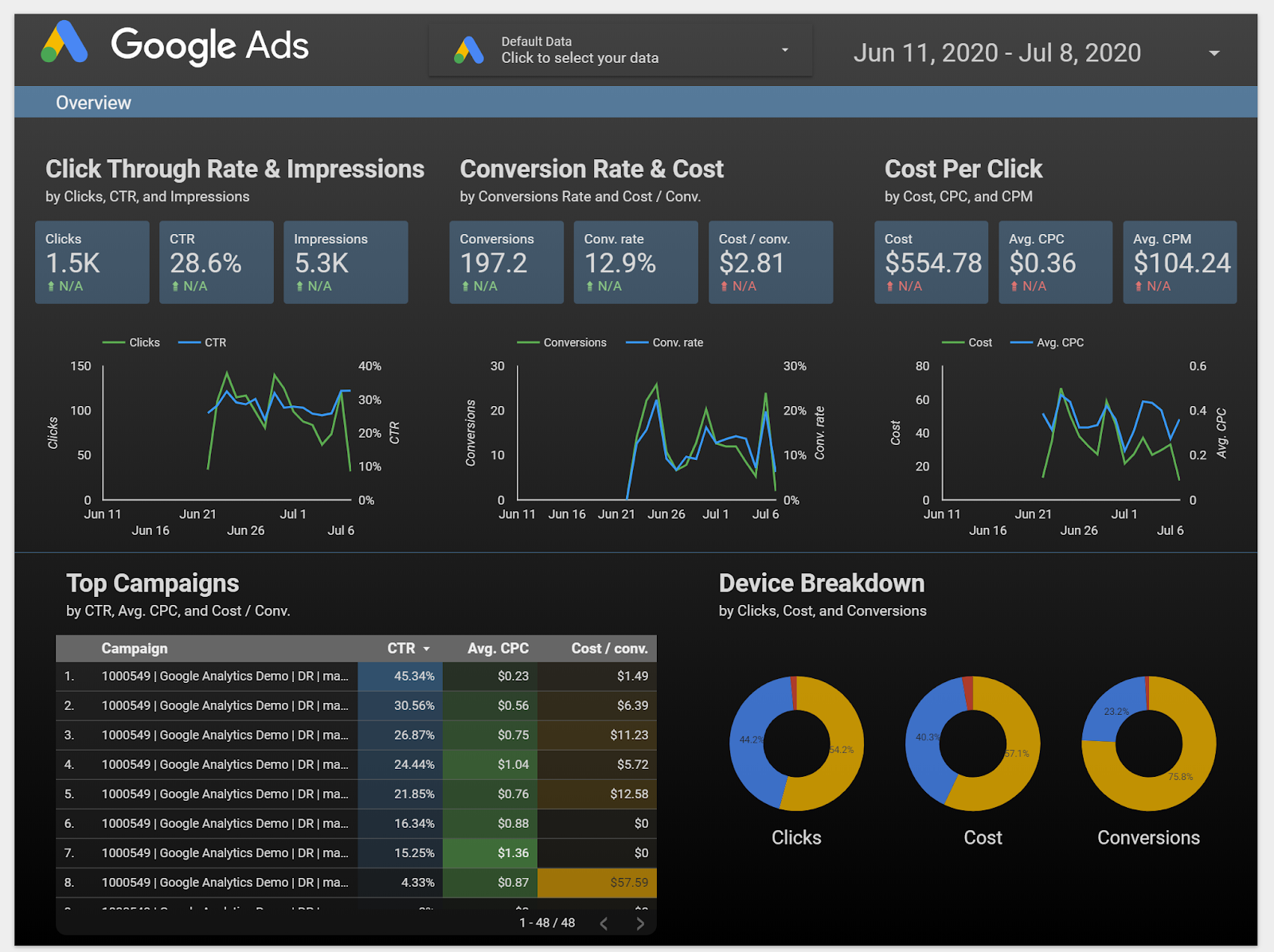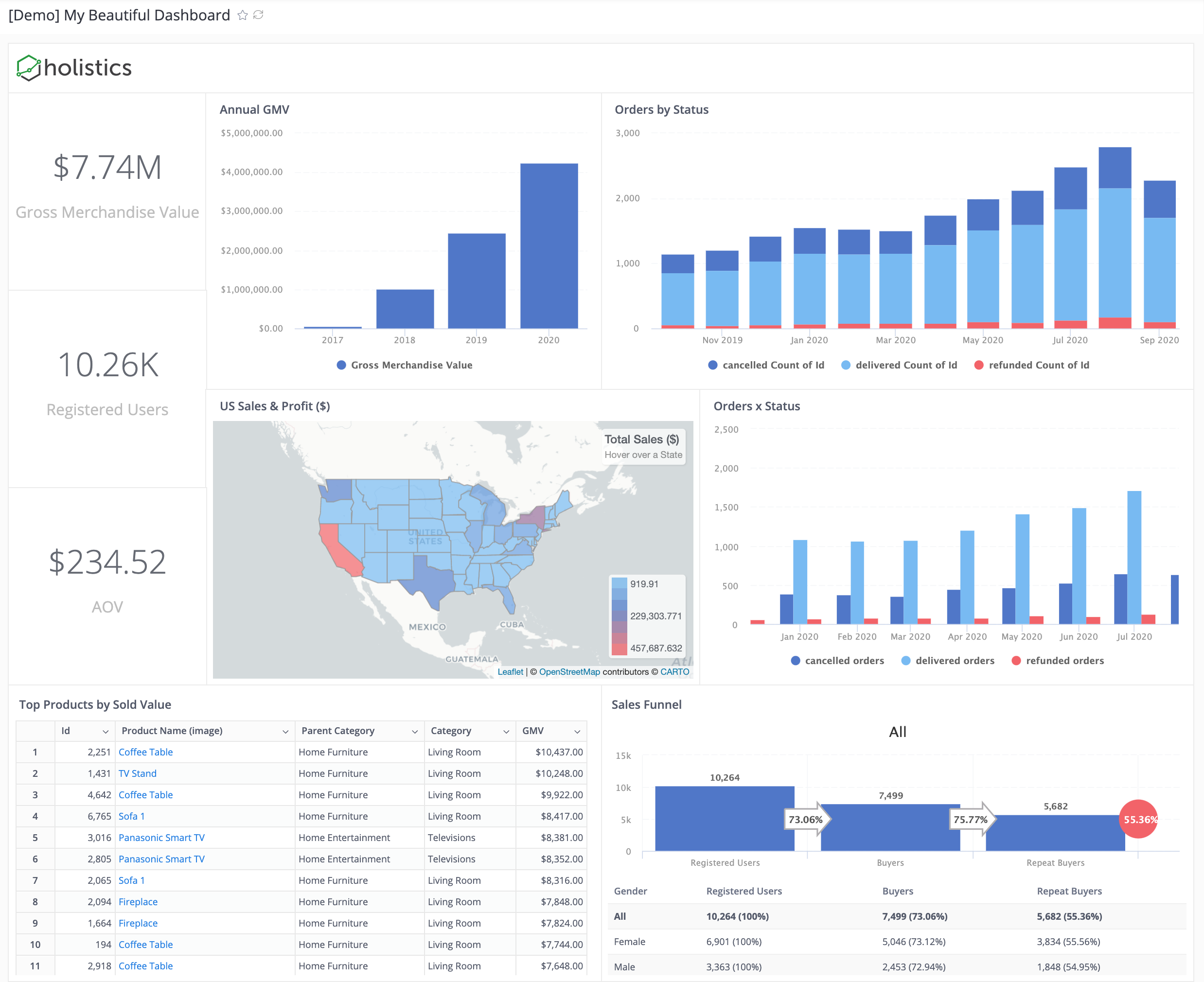Best Alternatives to Looker Studio (Google Data Studio) Alternatives

Looker Studio (previously Google Data Studio) is a reporting tool that nicely integrates within GA360 ecosystem (alongside Google BigQuery and Google Sheet) and evolves on a monthly basis with an intuitive interface to explore and build insights. And it's completely free.
The tool seems to target a set of semi-technical users, who work with numbers and know Excel very well. They might even know a bit of scripting language (Python, JS), but not technical enough to work on data infrastructure building full reports from scratch, or building complex analysis that requires some SQL acrobatics.

Nevertheless, Google Data Studio still has several limitations:
- Limited self-service data exploration capabilities. If you give the dashboard above to a user, it's highly likely that he doesn't know where to find relevant data or drill down/ drill through.
- Lack of auto data refreshing capability. If you want to have real-time data, you would need to install a third-party browser extension (like this one)
- If your data sources are not Google-owned and need to be integrated with Google Data Studio, it takes extra SQL code or ETL effort.
In this article, we will go through the top Looker Studio (Google Data Studio) alternatives, offering not only their own robust feature sets such as data modeling, self-service analytics, data reusability, etc. but also more flexible pricing plans. Hopefully, after reading our blog post, you’ll find the alternative that best fits your needs.
Choosing the right BI tool for your organization can be extremely tricky, so we dedicate another article on this topic, check it out here: Navigating The Business Intelligence Tool Space
Top Five Google Data Studio Alternatives
Holistics

Holistics is a powerful and scalable data platform for companies seeking an all-in-one data stack. Data Analysts can build a re-usable set of data for the Business Team to do self-service data exploration with minimal involvement of the data engineers
Pricing

Starting from $200/month, Holistics charges you based on your usage (or query runs) instead of user count which is quite affordable and more scalable in comparison to other products in the BI industry.
You can also use Holistics for free but of course, with limited query runs per month.
Pros
- Self-service analytics with an intuitive drag-and-drop interface for non-technical teams to answer ad-hoc data questions.
- Work well with almost all the popular databases in the market (PostgreSQL, MySQL, MS SQL, Snowflake, Amazon Athena, Google Big Query, etc.)
- Powerful delivery capabilities via Email/Slack Schedule and Alerts and shareable links.
- Have a custom-built DSL layer (called AML) to perform mapping between database tables and business logic, thus it's more flexible and customizable.
- Git Version Control to track every change, perform branching, and code reviews to ensure accurate analytics workflow
Cons
- You need to have a good foundation in Data Modeling concepts to fully master Holistics
- Holistics is a fairly new tool in the market so there are a lot of features still in the roadmap.
- The chart gallery can support most of the visualization needs, other complex charts are still under development
Power BI

Power BI is without a doubt a well-known Business Intelligence platform in the industry with a strong modeling capability and a rich set of visualization. It is also the first choice for every company that has adopted the Microsoft eco-system.
Pricing
For personal use, Power BI can be downloaded on your local machine for free. However, if you want to use more Power BI services, you will need to pay $9.99/user/month for a cloud solution or $4,995/month for a dedicated server (cloud compute and storage resource)

Pros
- Support Connecting Multiple Data Sources easily, from cloud service to flat files like Excel
- Visualizations Marketplace is very rich
- Fully customizable and interactive Dashboards
- PowerBI has an active community of power users and employees who are willing to deep dive into your use case to help you out
- PowerBI has mature data modeling capabilities.
Cons
- The learning curve is quite steep. Data analysts must learn DAX (Data Analysis Expression) and Power Query M language to fully leverage PowerBI's power.
- If you use Mac devices, you cannot install Power BI desktop version to prepare data logic for your team (that's why we wrote a post on how to use PowerBI on Mac devices)
- Power BI is your gateway drug into Microsoft’s ecosystem
Looker

Google Data Studio was renamed to Looker Studio after Google acquired Looker in 2020. This naming confusion has led to plenty of mix-ups, especially among newcomers to the analytics world who innocently refer to Looker Studio as "Looker," unaware that LookML Looker even exists.
Looker (LookML) is a modern analytics and BI platform that enables users to integrate, explore, and visualize data. Looker is primarily deployed in the cloud. Core to its approach is its data modeling language, LookML, in which data analysts write code to define business metrics and manipulate data. The platform supports a wide range of data sources and visualizations and can be embedded in websites, portals, and applications.
Pricing
Looker's pricing is customizable based on your needs so they don't public their price. Looking at some online communities, the price could range from $3000 - $5000 per month for 10 users with an annual subscription
Pros
- Tremendously powerful data modeling capability which can cover a variety of analytical use cases
- Fairly easy for non-technical team to create reports from pre-defined set of data
- Looker supports collaboration and version control with Git Integration
- Looker's pre-sale team is very helpful and supportive. They will go side-by-side with you for your initial setups.
Cons
- Steep learning curve (have to acquire LookML skills to work with models).
- Require a strong data team with high level of data maturity to manage LookML projects and do all the setups for your business team.
- Looker can only work directly on one database per project and does not offer ETL capability.
For more Looker analysis and evaluation, check out:
Tableau

Tableau is the most favorable tool in the BI industry with its appealing visualization capabilities that makes it outstanding among other software. If your company is looking for a BI product with fancy charts to present to the board of directors, Tableau will always be the first choice.
Pricing

Tableau is priced by users (like almost other tools) but it's varied depending on the role of your users. Creator, who builds the data flow and visualization in Tableau Desktop, is charged $70/user/month. Explorer and Viewer are fairly cheaper at $35 and $12 per user per month respectively for on-premise deployment. Please note that the price for Explorer and Viewer will go higher if you go on the cloud.
Pros
- A large library of charts and highly interactive dashboards
- Tableau supports a variety of data connection (database, application, CRM, etc.)
- High compatibility among devices (its dashboard can be viewed on multiple devices like tablet, mobile and laptops)
- The community is very helpful to new and existing users.
Cons
- Tableau focuses primarily on visualization and cannot work with uncleaned data. In order to efficiently use Tableau, you need to do proper data cleaning in the underlying database first.
- Lack data modeling and data dictionary capabilities for Data Analysts.
- The support team is very poor and some users said that they have to solve the issue by themselves.
- Lack of version control and collaboration when building data logic and dashboard.
Qlik Sense

Qlik Sense is a dynamic self-service analytics and visualization tool that simplifies data exploration for a full spectrum of users. With intuitive data prep, drag-and-drop abilities, and drill-down features, organizations can easily spot and share data relationships and key insights quickly and efficiently.
Pricing

Free and Starting from $30/user per month
Pros
- Helpful self-service analytics with a drag-and-drop interface
- Provide predictive analysis and trend indicators
- Allow centralized management through centralizing locations for users to develop and sharing apps, data stories and insights quickly and efficiently
- Robust mobile apps, designed with a mobile-first attitude
Cons
- Inflexible data extraction capabilities
- Limited visualization due to lack of some basic charts
- Complicated token pricing model
- Data solution is normally sluggish when working with large data sets
Conclusion
All the above products have their own benefits and drawbacks. Choosing a appropriate one for your company will be depended on a lot of aspects including the size of the company, your data maturity, your budget and importantly, the use cases you want to solve.
It is not one-day job so my recommendation is that you should involve all the related parties (data builders and data consumers) of your company to clearly list out all the requirements, narrow down to top 4-5 tools and try out all the tools.
If you need a little more pointer to choose the right tool, you might want to check out Chapter 4 in The Analytics Setup Guidebook which will discuss in detail how you can navigate the Business Intelligence tool space.
For more Google Data Studio analysis and breakdown, check out:
What's happening in the BI world?
Join 30k+ people to get insights from BI practitioners around the globe. In your inbox. Every week. Learn more
No spam, ever. We respect your email privacy. Unsubscribe anytime.

